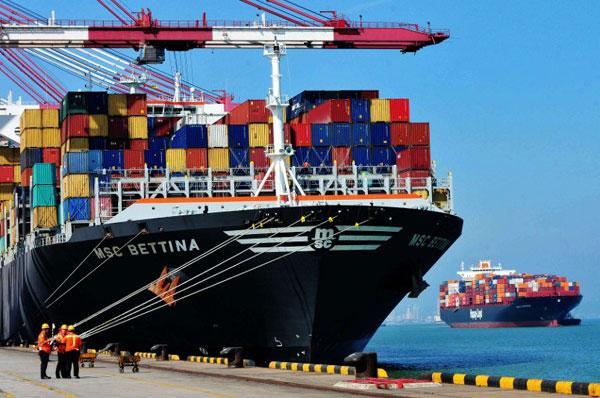
The Washington Post writes that in recent weeks, President Trump has threatened tariffs on $500 billion of Chinese imports, on $200 billion of auto imports from various countries and on any nation he perceives as ripping off the United States. "We are being taken advantage of," he said, adding, "and I don't like it." While the legal basis of such tariffs remains tenuous, and while (for now) these are closer to threats than policies, Trump's goal appears to be restoring a domestic manufacturing base that has long since been globalized. If a few tariffs are the only tools, that will fail. But a radical reinvention of our economy is possible if — big if — Trump and Republicans in Congress decide to do what China does. As it stands, alone, the level of tariffs being levied can't come close to compelling that change. Unless they're matched by massive public and private spending on domestic infrastructure, physical plants and training, those tariffs will amount to a de facto tax on American consumers. If Trump wants these tariffs to have their desired effect, he'll need somehow to erect high barriers on a wide range of goods and then galvanize Congress to undertake a domestic spending program unparalleled since the New Deal and the retooling of domestic industry during World War II. And that spending will need to be channeled and focused on building a manufacturing and transportation infrastructure on a scale that only one country in the world has done in the past 50 years: China. If Trump wants to make America self-sufficient in all key aspects of its economy, he'll need to emulate not just Franklin D. Roosevelt, but also Deng Xiaoping and Xi Jinping.
The Wall Street Journal writes that for years, China has sold much more to the world than it has bought. Now, that imbalance is shrinking, helping Chinese leadership argue it no longer pursues a mercantilist policy. Official data set to be released Aug. 6, economists say, likely will show China's current account, which measures its transactions with the rest of the world, was in deficit for the six months ending in June, essentially meaning it imported more than it exported. Macquarie Capital Ltd.'s economist Larry Hu estimates the deficit was $24 billion, largely occurring in the first quarter. It would be the first half-yearly deficit since the country joined the global trading system in 2001. Increased imports of foreign oil, iron ore and other commodities, along with greater spending by Chinese companies on foreign financial and software services, drove the turn. For the year overall, economists still expect China to run a current-account surplus, to the tune of $100 billion, as weakening growth leads to reduced Chinese purchases from abroad. But that surplus would represent less than 1% of China's gross economic product, its smallest surplus since 1995. By comparison, China's current-account surplus reached nearly 10% of GDP in 2007. The ratio has been declining since then and firms including Morgan Stanley and Standard Chartered estimate that such a surplus will further drop to 0.5% of GDP in 2019. "It's a sea change," says Mr. Hu, a Hong Kong-based economist with Macquarie. "China can use the narrowing current-account surplus as evidence that it doesn't have a mercantilist policy of keeping the yuan artificially cheap to gain a leg up on global trade."
- 2018-07-27 China Rails Against U.S. Trade Attacks With New Tariffs Looming
- 2018-07-26 Lone suspect in blast near U.S. embassy in Beijing caught
- 2018-07-25 Giving In to China, U.S. Airlines Drop Taiwan (in Name at Least)
- 2018-07-24 Defense bill offers harsh words for Russia and China
- 2018-07-23 U.S.-China trade war is now becoming a currency war, too
- 2018-07-22 China Premier Orders Probe Into Vaccine Makers After Violations
- 2018-07-20 Trump: ‘Ready to go’ with tariffs on all Chinese imports
- 2018-07-19 A China Borrower’s $11 Billion Debt Mountain Comes Crashing Down
- 2018-07-18 The trade war is complicating China's efforts to fix its economy
- 2018-07-17 The President Turns the Tables on China
- Reuters UK's new foreign minister in China for first overseas visit
- AXIOS.com Charles Koch warns that Trump's trade war could be "disastrous"
- Wall Street Journal Jack Ma's Giant Financial Startup Is Shaking the Chinese Banking System
- AXIOS.com BMW to increase prices on US-made SUVs in China
- Reuters Chinese police apply to arrest 18 at scandal-hit vaccine firm
- uk.reuters.com China donates four small boats and grenade launchers to Philippines
- uk.reuters.com Beijing city reports slowest mortgage growth in five years - Xinhua
- Reuters China's premier says Tibet inseparable part of country's 'sacred' territory
- The Hill Fewer international students could become a problem for US universities
- Wall Street Journal US Almond Farmers Are Reeling From Chinese Tariffs
- Wall Street Journal #MeToo Movement Gathers Momentum in China
- The Hill Fewer international students could become a problem for US universities
- CNN Donald Trump is a real estate developer. He doesn't get the benefits the US gets from trade
- nationalinterest.org China's Underwater 'Nukes': Country-Killers or Paper Tigers?
- The Hill Space: The last frontier for cybersecurity
- nationalinterest.org China May Soon Have a New Weapon to Kill Navy Submarines
